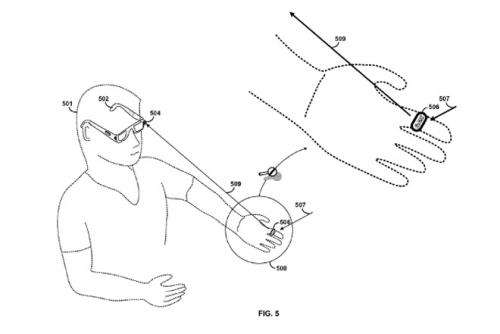May 19, 2012 report
Google patent sends ring signals to Project Glass

(Phys.org) -- Google's September 2011 patent that was filed for a wearable display device was granted this week, which suggests that its envisioned heads-up display device can be controlled by infrared markers in the form of devices worn on the hands, such as fake fingernails or rings. The patent says, “A wearable marker may take the form of a ring, a bracelet, an artificial fingernail configured to be affixed to a fingernail, a decal configured to be affixed to a fingernail, or a glove, among other possible wearable items."
The popular translation of this patent can be worded as something like Google has revealed how its Project Glass video glasses will actually work, and the answer is with hand gestures via rings, fake nails, or some sort of hand tattoo. A certain gesture pattern could launch an application or open a document.
According to the patent, the reflective infrared identifier that is placed on a user’s hand is able to track and identify the user’s gestures. The head-mounted display and IR camera device can function together. The infrared camera is integrated into the user’s head display to track the image. The camera would pick up radiation reflected from the marker, as a point of reference for user control. IR reflective material could be an IR reflective paint, and an IR absorptive material could be an IR absorptive paint.
The patent provides insight into yet another possibility in wearable computer interfaces. Some users may feel self-conscious about talking aloud in public, with voice-based control systems, whereas control gestures in the form of head-nods may also look odd to passers-by. As for the hand-gesture idea, one blogger suggested it may be no-less conspicuous as if one was conducting music, without the music. Another reactive line of discussion this week is whether or not the patent means anything more than a patent. Most suggestions point to the patent as part of a grand scheme of project development for Google’s glasses.
Google announced Project Glass last month, where a special research team is testing prototypes outside the office. Closer details for this “Augmented Reality system,” or a smartphone-free smartphone in the form of video glasses, are not to be had, as the project is in its early stage. The patent revealed earlier this week, though, suggests that Google’s “wearable marker for passive interaction” is on the roadmap as one among other input solutions for Project Glass.
More information: Patent online: patft.uspto.gov/netacgi/nph-Pa … &Sect2=HITOFF&p=1&u=%2Fnetahtml%2FPTO%2Fsearch-bool.html&r=1&f=G&l=50&co1=AND&d=PTXT&s1=8179604&OS=8179604&RS=8179604
© 2012 Phys.Org





















